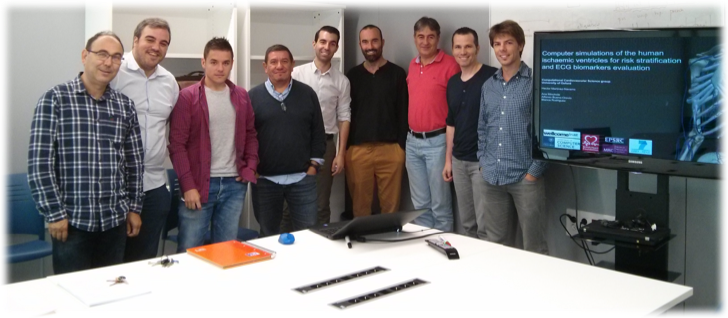
The V-Heart SN network is made up for nine universities and research centres of international reference in this field.
It is focused on the development of a computational cardiac model - virtual heart - that could be adapted to each patient. It will allow to design a personalized treatment more efficient and safe
It will help to better understand the mechanisms that generate and maintain cardiac arrhythmias, as well as to optimize the application of therapies (cardiac resynchronization, defibrillation, pacemakers, etc.) and predict the efficiency of drugs and their cardiotoxicity.
A total of nine universities and research centres in which we can find the CoMMLab located in the ETSE, have launched the Spanish Research Network in Computational Cardiac Modeling. Under the acronym V-Heart SN, this network is supposing to make easier the use of virtual hearts - computational hearts- in the daily clinic practice, which will allow the design of personalized therapies more effective and safe.
According to the Dr. Rafael Sebastián responsible for V-Heart SN in the CoMMLab group, ‘the use of cardiac models of the heart will help to plan complex interventions and to study clinical hypotheses in a controlled environment that will emulate the real behaviour of the patient’s heart’.
The network aims to bring together different areas of knowledge and encourage the creation of mathematical methods and more advanced simulation tools, which will result in the quality of the models, thus allowing them to be transferred to clinical settings for validation and implementation.
The CoMMLab group brings to the network its experience in the construction of 3D models of the heart from medical data of a patient, in order to carry out simulations of the electrical activity of the heart. In addition, thanks to the multidisciplinary nature of the group, in which physicists, mathematicians and computer scientists participate, they are also beginning to apply machine-based techniques in order to guide cardiologists in the diagnosis and planning of complex interventions.
‘One of the most important challenges that we face in the network is the validation of models, in other words, its ability of predictable power and adoption in clinic environments’, Dr. Sebastián says. The development of this computational model of heart will help to understand better the mechanisms that create and keep cardiac arrhythmias, will also allow optimizing the application of therapies (cardiac resynchronization, defibrillation, pacemaker, etc.), as well as predict the efficiency of the drugs and their cardiotoxicity.
V-Heart SN will work in the search of new computational solutions to the challenges of clinical research in the cardiovascular area, as well as to position itself as a national and international point of reference in cardiac modeling, strengthening the position of Spanish science in this field.
Together with the Universitat de València, the University of Navarra, the Universitat Politècnica de València, the Universitat Politècnica de Catalunya, the Basque Center for Applied Mathematics, the International Center for Numerical Methods in Engineering, the Pompeu University are all part of V-Heart SN Fabra, the Barcelona Supercomputing Center and the University of Zaragoza. Moreover, the network has the collaboration of the main hospitals and benchmank national companies.
Images:

















